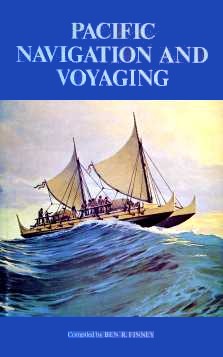|
Pacific navigation
and voyaging / compiled by Ben R. Finney. - Wellington (New Zealand) :
The Polynesian society, 1976. - 146 p.-[1] folded leaf of plate : ill., maps ;
25 cm. - (Memoir, 39).
|
BEN R. FINNEY : […]
What do we learn about voyaging
and navigation in the Pacific from the research findings reported
in this volume ? It would be a mistake to attempt to use
these findings to « prove » this or that
theory about navigation or settlement. The experiments described
here cannot be considered « crucial experiments »
that conclusively confirm or negate a hypothesis. Similarly,
a computer simulation does not tell you what actually did, or
will, happen in the real world. And, needless to say, ethnographic
findings are seldom definitive. What these reports, and other
recently published field research findings, do provide is new
data that contribute toward a better understanding of how Pacific
Islanders were adapted to the sea.
It is apparent, for example,
that the Micronesians and Polynesians, and perhaps some of the
peoples of Melanesia, shared a unique deep-sea adaptation. With
their many types of ocean-going canoes, their use of the stars
and other natural phenomena for navigation, and their sensual
and emotional familiarity with the sea, these Pacific Islanders
were able to treat the oceans as an avenue, not a barrier, to
communication. They were not, however, conquerors of the sea.
Adaptation, not conquest, is the appropriate term to denote how
they had learned to travel through the Pacific, for voyaging
and navigation was (and still is for some) a matter of man adapting
his technology and life style to the wind, stars, swells and
other aspects of his oceanic environment.
[…]
☐ New, non-armchair research, p. 9
|
| CONTENTS |
Introduction : New, non-armchair
research, Ben R. Finney
Part I : Experimental research
- A return voyage between Puluwat
and Saipan using micronesian navigational techniques, David Lewis
- Wa, vinta and trimaran, Edwin Doran Jr.
- Paddling experiments and
the question of polynesian voyaging, Steven M. Horvath & Ben R. Finney
Part II : Computer simulation research
- The settlement of the polynesian
outliers : a computer simulation, R. Gerard Ward, John W. Webb & M. Levison
Part III : Ethnographic research
- Sailing with the Amphlett
islanders, Peter K. Lauer
- The organisation of navigational
knowledge on Puluwat, Saul
H. Riesenberg
- A renaissance in Carolinian-Marianas
voyaging, Michael McCoy
|
|
SERGE DUNIS : Ben Finney est le grand nom de
l'anthropologie du Pacifique, celui qui, en quittant sa Californie
natale en pirogue reconstituée, a sorti la discipline
de la théorie pour la soumettre à la pratique.
Depuis son trajet épique entre Hawai'i et Tahiti en pirogue
double barrée sans instruments, tous les archipels du
Grand Océan, ainsi remis en phase avec leur tradition
hauturière, ont repris les routes maritimes. Ben Finney
vient de se retirer après avoir dirigé le Département
d'Anthropologie de l'Université d'Hawai'i dix ans durant
et initié l'anthropologie de l'espace. Il se consacre
désormais à l'écriture et travaille beaucoup
avec le Bishop Museum d'Honolulu. Dans son immense bibliographie,
citons : Hokule'a, the way to Tahiti, New York, Dodd,
Mead & Co., 1979 ; Voyages of rediscovery, a cultural
odyssey through Polynesia, Berkeley, Los Angeles, London,
University of California Press, 1994.
☐ « Le
Grand Océan : le temps et l'espace du Pacifique »,
Genève : Georg Éd., 2003 (p. 12)
|
|
| mise-à-jour : 13 septembre 2005 |

| |
|